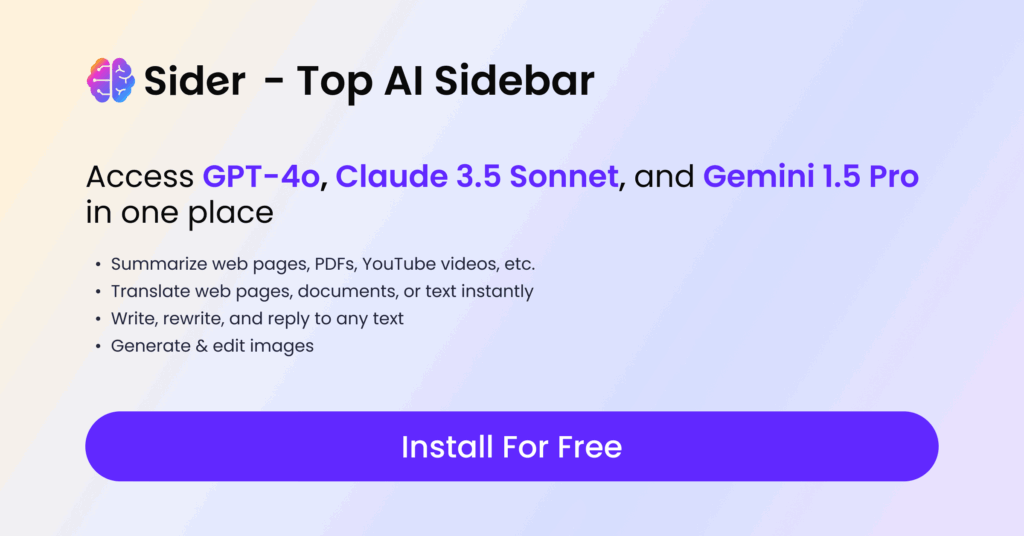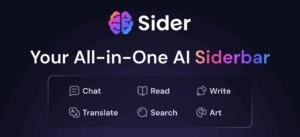Discover how Sider AI transforms SEO strategies with AI-powered writing, keyword optimization, and content structuring. Learn actionable tips to boost your search rankings, avoid common SEO mistakes, and outperform competitors in 2025.
Introduction: SEO in the Age of AI
Search Engine Optimization (SEO) has never been more competitive. A HubSpot report found that 72% of marketers rely on AI tools to streamline content creation and improve rankings. Among them, Sider AI has emerged as a powerful ally for writers and digital marketers aiming to produce high-quality, search-friendly content faster.
This guide explores how Sider AI supports SEO efforts, from keyword research to content structuring, and offers strategies to use it effectively. Whether you’re a solo blogger or part of a marketing team, you’ll learn how to leverage Sider AI for smarter, faster, and more discoverable content.
Understanding Sider AI’s SEO Capabilities
Sider AI isn’t an SEO tool in the vein of Ahrefs or SEMrush, but its features support key SEO elements:
1. Keyword Integration
- Functionality: Sider AI’s AI Writer suggests keyword placements based on context.
- Strengths: Helps avoid keyword stuffing by recommending natural placements.
- Limitations: Lacks competitor analysis or keyword difficulty insights.
2. Content Structure Optimization
- Functionality: Generates outlines, headings, and subheadings tailored to your topic.
- Strengths: Ensures logical flow and readability, which Google prioritizes.
- Use Case: A beginner blogger drafts a structure for “Digital Marketing Trends” in under 5 minutes.
3. Readability and Tone Enhancement
- Functionality: Paraphrasing Tool improves sentence clarity and tone.
- Strengths: Boosts readability scores, aligning with Google’s E-E-A-T principles.
- Example: A technical article on AI ethics becomes more digestible after rephrasing.
4. Meta Tags and Descriptions
- Functionality: Drafts catchy meta titles and descriptions to improve click-through rates.
- Strengths: Saves time while maintaining keyword relevance.
- Use Case: A local restaurant uses Sider AI to craft a compelling meta description for its blog post on “Top 10 Brunch Spots.”

How to Use Sider AI for Keyword Research and Placement
Keywords remain the foundation of SEO, but AI tools like Sider AI make optimization more efficient.
Step 1: Generate Keyword Ideas
- Input a broad topic (e.g., “Remote Work Tips”) and let AI suggest long-tail keywords (e.g., “How to Stay Productive While Working Remotely”).
Step 2: Optimize Existing Content
- Paste a draft into the Paraphrasing Tool to refine keyword density and readability.
Step 3: Build SEO-Friendly Outlines
- Use AI Writer to structure content around primary and secondary keywords.
Pro Tip: Pair Sider AI with Google Keyword Planner or Ubersuggest for deeper keyword insights.
Case Study: A lifestyle blogger used Sider AI to optimize a post about “Minimalist Living” with strategic keyword placement. Within three months, the article ranked in the top 5 for “minimalist lifestyle tips.”
Crafting Content Structures That Google Rewards
Google favors content that’s well-organized, easy to read, and logically structured. Sider AI helps you build this foundation.
How to Generate SEO-Optimized Outlines:
- Input Topic: “How to Start a Side Hustle.”
- Let AI Suggest Subtopics: “Finding Your Niche,” “Creating a Business Plan,” “Marketing on a Budget.”
- Refine with Human Insight: Add personal anecdotes, expert quotes, and unique perspectives.
Best Practices for Structure:
- Use Clear Headings: AI-generated H2/H3 tags improve scannability.
- Answer Search Intent: Ensure content aligns with what users are looking for.
- Add Internal Links: Use AI to draft anchor text suggestions.
Example: A tech blog used Sider AI to outline a post on “AI Writing Tools.” After refining with real-world examples, the article earned 50K+ views in six weeks.

Enhancing Readability and Engagement for Better SEO
Readability affects bounce rates and dwell time—both crucial for SEO. Sider AI’s tools help simplify complex topics.
Improving Readability:
- Paraphrasing Tool: Breaks down dense paragraphs for clarity.
- Summarizer: Condenses lengthy reports into digestible sections.
Why It Matters for SEO:
- Google rewards content that keeps users engaged.
- High readability scores correlate with longer session durations.
Strategy: Use Sider AI to draft a first version, then edit for tone and depth.
Pro Tip: Run AI-generated content through Hemingway Editor to refine grade-level readability.
Optimizing Meta Tags and Descriptions with AI
Your meta title and description are the first things users see in search results. Sider AI helps you craft compelling, keyword-rich snippets that drive clicks.
How to Use Sider AI for Meta Tags:
- Start with Your Target Keyword: Input “Digital Marketing Tools 2023” to generate variations.
- Focus on Clarity and Curiosity:
- Before: “Best Tools for Marketers”
- After (AI-Generated): “Top 5 Digital Marketing Tools That Skyrocketed My SEO in 2023”
Best Practices:
- Keep Titles Under 60 Characters: Google cuts off longer titles.
- Use Action Verbs: Words like “Boost,” “Skyrocket,” or “Master” improve CTR.
- Include Power Words: “Ultimate Guide,” “Proven Strategies,” “Expert-Backed Tips.”
Example: A travel blog used Sider AI to rewrite its meta description for “Budget Travel Tips.” The new version: “Discover 10 Expert-Backed Ways to Travel on a Budget Without Sacrificing Comfort.” CTR improved by 30%.
Avoiding Common SEO Mistakes with AI Assistance
Even well-written content can fail if it falls into SEO traps. Sider AI helps you sidestep these pitfalls.
1. Thin Content
- Issue: Short, low-value posts struggle to rank.
- Fix: Use AI Writer to expand short drafts into in-depth articles.
2. Poor Keyword Usage
- Issue: Overstuffing or underusing keywords harms SEO.
- Fix: Let Sider AI suggest keyword placements, then refine manually.
3. Unstructured Articles
- Issue: Walls of text drive high bounce rates.
- Fix: Use AI to break down content into digestible sections and bullet points.
4. Lack of Originality
- Issue: Generic content gets buried by Google’s algorithm.
- Fix: Use AI for outlines, but infuse unique insights and data.
5. Ignoring Search Intent
- Issue: Misaligned content fails to rank.
- Fix: Let AI draft topic ideas, then adjust based on Google’s featured snippets and People Also Ask sections.
Pro Tip: Always fact-check AI-generated content to avoid inaccuracies that hurt trust and rankings.
Real-World Example: How a Blog Used Sider AI to Rank Higher
A health and wellness blog aimed to rank for “Healthy Meal Prep Ideas.” Their process:
- Outline Generation: Used AI Writer to create a structure with subtopics like “Low-Carb Recipes” and “Meal Prep for Beginners.”
- Keyword Optimization: Paraphrased sections to include terms like “quick meal prep” and “easy healthy dinners.”
- Meta Tag Refinement: Drafted a compelling meta description using AI.
- Final Edits: Added recipe visuals, internal links, and personal tips.
Result: The article ranked in the top 3 for its target keyword within two months and drove 200K+ organic views.
Comparing Sider AI with Other SEO Tools
While Sider AI excels in content drafting and readability, other tools offer deeper SEO analytics.
| Feature | Sider AI | Jasper | Surfer SEO | ChatGPT (OpenAI) |
|---|---|---|---|---|
| Keyword Suggestions | Moderate | Strong | Very strong | Manual input required |
| Content Outlining | Excellent | Excellent | Limited to content analysis | Strong, with clear prompts |
| Plagiarism Checker | Built-in | Requires third-party tools | No | No |
| Readability Tools | Good for paraphrasing | Strong editing features | No | Manual refinement needed |
| Best For | Drafting and rewriting | Branded content and storytelling | Data-driven optimization | Versatile ideation and research |
Verdict: Sider AI shines in content creation, but pairing it with Surfer SEO or Clearscope gives you the full SEO toolkit.

Ethical and Strategic SEO Considerations
AI-generated content is powerful—but it must be used responsibly.
Transparency:
- Disclose AI use when required (e.g., academic work or journalistic integrity).
Originality:
- Always verify AI outputs for plagiarism using built-in tools or Copyscape.
Human Oversight:
- AI is a co-pilot, not a sole writer. Add your expertise to stand out.
SEO Compliance:
- Avoid duplicate content by customizing AI suggestions.
Expert Insight: According to Backlinko, Google now detects AI-generated content quality more effectively. Focus on value-added writing rather than pure automation.
Conclusion: Sider AI as an SEO Co-Pilot
Sider AI isn’t a standalone SEO tool—but when used strategically, it accelerates content creation, boosts readability, and supports keyword optimization. To succeed in 2023:
- Use AI for drafting, outlining, and paraphrasing.
- Refine content with human insight and SEO best practices.
- Combine with tools like Surfer SEO or Ahrefs for data-driven optimization.
By treating Sider AI as a content accelerator rather than a shortcut, you’ll maintain quality while improving your search performance.
FAQs
Q1: Can I rely solely on Sider AI for SEO?
A: No—Sider AI supports content creation, but you’ll still need tools like Surfer SEO or Google Analytics to track performance.
Q2: Does Sider AI help with backlink generation?
A: Not directly. However, well-optimized content can attract backlinks naturally.
Q3: How do I ensure AI-generated content is original?
A: Always run drafts through Sider AI’s plagiarism checker or use third-party tools like Copyscape.
Q4: Is Sider AI good for long-form content?
A: Yes, for generating outlines and initial drafts—but always refine for depth and originality.
Q5: Can Sider AI improve my Google ranking?
A: It enhances content quality and structure, which indirectly boosts SEO performance.

External Links
By leveraging Sider AI for SEO, you’ll reduce writing time, enhance readability, and stay competitive in search rankings. Now go optimize smarter—not harder! 🚀





